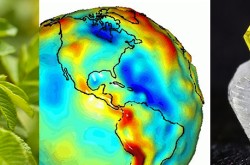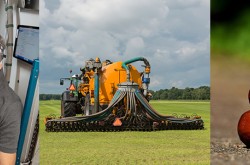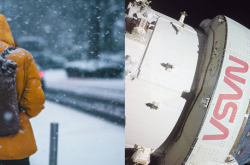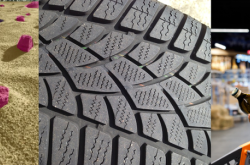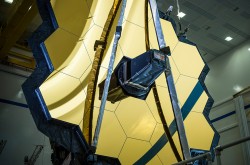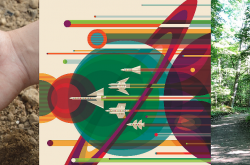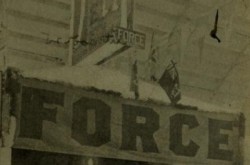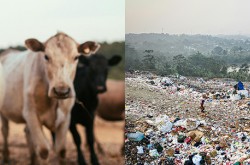3 Things you should know about radon in your home, Saturn's Trojan asteroid and 3D printed food

Meet Michelle Campbell Mekarski, Cassandra Marion, and Krissy Draper.
Michelle and Cassandra are two of Ingenium’s science advisors, providing expert scientific advice on key subjects relating to the Canada Science and Techonology Museum and the Canada Aviation and Space Museum, respectively. Guest contributor Krissy Draper is a science communications intern at the Canada Agriculture and Food Museum. She is filling in this month for Renée-Claude Goulet, science advisor at the Canada Agriculture and Food Museum.
In this colourful monthly blog series, Ingenium’s science advisors offer up three quirky nuggets related to their areas of expertise. For the March edition, they explore radon radiation in the home, the discovery of a new Trojan asteroid around Saturn, and the innovation of 3D printing food.

Would you eat a pancake printed with a 3D printer?
From Printer to Plate: The Culinary World’s Next Biggest Thing
Have you ever thought of printing your food, instead of cooking it? Food engineers across the world are looking to do just that, printing our favourite foods and printing our meals. The 3D food printing industry, while not necessarily a new concept, has been hitting new highs.
The 3D printing of food in specialized food-safe 3D printers is done by uploading a digital file to the printer. The printer then takes the ingredients, which come in the form of a paste, and does its magic, squeezing out food paste just like a regular 3D printer extrudes molten plastic! Let’s look at how this might be done through an example from research at Columbia University in New York, where they were able to make a cheesecake with a 3D food printer.
Most 3D food printers work similarly to regular 3D printers. Some, though, are more advanced and are equipped with a laser for baking, and they extrude blobs of different edible ingredients, like graham cracker paste or strawberry jam. However, since the ‘ingredients’ are soft food pastes, the food needs to be printed and built up in layers to make the foods firm. The more viscous ingredients are printed first, with the softer pastes following. This allows the harder ingredients to support the softer ingredients, and the structure of the food mimics what we are used to seeing. For example, when printing a cheesecake, the graham cracker base is printed first. The heat of the lasers turns the graham cracker paste into a solid, providing the perfect base for Columbia University’s seven ingredient cheesecake.
What food have scientists already been able to print? Scientists, or we can call them chefs, have experimented with 3D printing a wide variety of foods: from cheesecake, to plant-based salmon , to even a pizza with all the toppings! As more trials are done and scientists try to make different foods, the 3D food printing industry will continue to develop, and other foods will be attempted.
So why is 3D food printing becoming a growing industry? Food printed with a 3D printer can be completely customizable to any shape, any flavour desire, and to even any nutritional need. 3D printed food could possibly be the answer to a lot of issues we face feeding a growing and aging population. One benefit of 3D printed food is that scientists can manipulate the ingredients to target a specific nutritional need. For example, they are working with individuals with dysphagia, a condition in which patients experience difficulty when swallowing, to curate 3D printed food that is easy to swallow but also visually appealing and appetizing. Food that would normally be puréed, bland, and perhaps be low in nutritional variety can, through 3D printing, be made to be more nutritious and appealing and taste like the real, non-printed item! The ability to feed a growing but also aging population with nutritious and easily digestible food could become a gamechanger for the future of the culinary industry.
To wrap up, 3D food printing is “cooking up” a whole new world of possibilities, and the sky is the limit. Who knew the future of food would come from a printer that could help many people rediscover tasty, nutritious food? The world of 3D food printing has just begun, and the plate is wide open for innovation!
By Krissy Draper

One test could save your life. Have you checked for radon?
Is my home radioactive? The invisible risk of radon gas
Smoke detector? Check. Carbon monoxide detector? Check. Radon detector? If you said no, you’re not alone – 95% of Canadian homes have never been tested for radon. This invisible, odorless gas seeps up from the ground and can accumulate indoors, posing serious health risks. Radon is the second leading cause of lung cancer after smoking, but most homeowners have no idea they’re being exposed. The good news? Testing is simple, and if your home has high radon levels, there are effective ways to fix it.
What is radon and where does it come from?
Though we may think of rocks and soil as permanent and unchanging, they’re constantly breaking down in slow, natural processes. Some rocks naturally contain uranium, which breaks down into radon gas. As a gas, radon moves upward through layers of rock and soil, escaping constantly and harmlessly into the atmosphere. However, radon gas can also move upward into homes through cracks in foundations, gaps around pipes, and even through well water. Once inside, radon can get trapped and accumulate to dangerous levels.
Canadians are exposed to some of the highest levels of radon in the world. This is partly due to the amount of uranium (and therefore radon) in our rocks. But it’s also due to the way we build our homes. Hot summers and long, cold winters means that most homes in Canada are well sealed, which can trap radon gas inside. Forced air heating can also create negative pressure, pulling more radon inside. The type and size of your home affect the amount of contact with the soil and the number of ways radon can enter (large, single-family homes typically have higher radon levels). Our lifestyle also matters. Canadians spend a lot of time inside (thanks again to hot summers and cold winters) which also increases our exposure.
How worried should I be?
The biggest danger of radon exposure is lung cancer. As radon decays, it releases tiny radioactive particles. When inhaled, the radiation from radon and these particles damages lung tissue, increasing the risk of lung cancer over time. In fact, radon is the leading cause of lung cancer among non-smokers.
Living in a high-radon home can increase your risk of lung cancer as much as smoking one or more packs of cigarettes a day. Higher radon levels and longer exposure times increase the risk – especially for children and smokers. It’s estimated that nearly one in five Canadian homes has high radon levels, making testing an important step in protecting your health.
How can I check my home for radon?
Simple! You can purchase a do-it-yourself radon test kit or hire a radon measurement professional. Unfortunately, you can’t rely on maps because radon levels can vary dramatically from one house to the next – even in identical homes right next to each other – due to differences in construction, the underlying soil, and the cracks and openings created as the house was built and aged.
Getting rid of radon
If your test results show high radon levels, don’t panic, its fixable. The most effective way is called “sub-slab depressurization”. This is essentially a pipe that runs from the soil beneath your house, providing a way for radon to bypass your home and escape into the air.
A simple fix for a big risk
Radon might be invisible, but the risk is real. The solution? Test your home. If levels are high, fixing it is straightforward. If you haven’t tested yet, now is the time—because breathing shouldn’t be a health hazard!
By Michelle Campbell Mekarski
Go Further:

Saturn and its rings
Saturn’s First Trojan Asteroid
A Trojan asteroid has finally been discovered for the second-largest planet in the solar system.
Trojans are small rocky or icy objects that reside at stable regions in a planet’s orbit called Lagrange (L) points. These points are places where the gravitational forces of the Sun and a planet balance out, allowing objects to stay in place. Trojans can either be formed in these positions or captured from elsewhere. These small bodies may hold clues to the formation of our early solar system.
Jupiter has thousands of Trojan asteroids that are trapped at the L4 and L5 points of Jupiter's orbit, 60 degrees ahead and behind the planet. The first Trojan of Jupiter was discovered in 1906 by German astronomer Max Wolf. Non-Trojan asteroids also orbit between Mars and Jupiter, known as the asteroid belt. Despite Saturn having been the only gas giant without, as Uranus has one Trojan, and Neptune, 31, this new discovery of 2019 UO14 confirms that Saturn does indeed have a Trojan of its own.
The 13 km-wide asteroid, named 2019 UO14, was discovered and studied by an international group of astronomers including two Canadians. To confirm its orbit, astronomers needed extensive observations from multiple telescopes over a long period of time. Once the necessary data were collected, the astronomers were able to determine and confirm its precise orbit. Though this discovery is exciting, models show that the asteroid is transient, meaning it will probably only remain in its position for another thousand years or so. 2019 UO14 orbits the Sun once every 30 years, similar to Saturn's own orbit, and it resides about 60 degrees ahead of the planet in its orbit.
The absence of Saturn Trojans was previously thought to be due to planetary migration, collisions, and smaller stable regions in Saturn's L4 and L5 points compared to those around Jupiter. However, this discovery opens the possibility that Saturn may have more Trojans waiting to be found.
This discovery is also significant in the context of NASA's Lucy mission, which is currently on its way to study Jupiter's Trojan asteroids. Lucy is designed to explore the ancient bodies at Jupiter’s L4 and L5 points to uncover vital clues about the solar system’s formation. The mission's success could shed light on the origins of asteroids like 2019 UO14 and enhance our understanding of planetary migration and the early solar system. As scientists continue to examine these distant objects, future missions like Lucy may reveal even more surprising insights into the role of Trojans in the evolution of the solar system.
By Cassandra Marion
Enjoying the Ingenium Channel? Help us improve your experience with a short survey!






